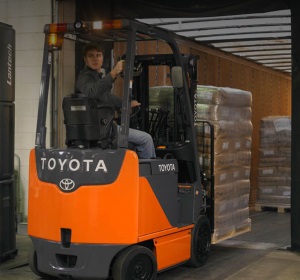Complete Powerpoint slide presentation for forklift instructors. Ready made training course
The safe use of forklift trucks on loading docks
 This article is based on a similar one from Jake
Stewart of Toyota forklift trucks
and has some additions relating to the VOSA requirements for UK operators.
This article is based on a similar one from Jake
Stewart of Toyota forklift trucks
and has some additions relating to the VOSA requirements for UK operators.
Loading Dock safety
Forklift accidents can happen anywhere, but because loading docks are typically narrow and elevated, they’re one place where extra caution should be used. Common loading dock incidents include falling off the edge of the dock, and skidding or slipping due to wet or icy conditions. So how can the risk of loading dock accidents be reduced?
First and foremost, make sure the trailer is secured to the dock using a locking device, either on the trailer’s rear impact guard or rear wheel. One common and dangerous issue that can arise when loading and unloading trailers in a loading dock, is the truck driver not realizing the forklift is still in the truck and pulling away, which causes the forklift to roll out.
“Trailer Creep”, which happens when trailers gradually move away from the dock because of constant movement inside them, can also happen. The only way to prevent these two things from happening is to completely secure the trailer with a locking device on the trailer’s rear impact guard or rear wheel. At the very least. the lorry wheels should be chocked.
Clean off the surface of the loading dock. One common cause of accidents involving forklifts and loading docks is ice or water covering the dock. Clean the dock off before operating the forklift on it to help prevent sliding issues.
Operators should remember to always maintain a safe distance from the edge of the loading dock. HSE doesn't’t recommend a specific measurement between a forklift and the edge of a loading dock, but you should implement good judgment to avoid falling off the side of the loading dock. Painting the edges of the loading dock a bright color is one thing you can do to help forklift operators stay aware of dock edges.
By doing the three things above, you’re well on your way to reducing accidents on loading docks, but keep these things in mind too:
- Anyone operating a forklift should be trained. Proper operating training is the number-one way to prevent accidents.
- Implementing a daily loading dock inspection is important to the safety of operators and truck drivers alike.
- Keep the product secure on your pallets by covering them in plastic or metal.
- Double check floors of trailers before driving on them to ensure they’re sturdy enough to handle the weight of the forklift.
- Consider creating a dock shelter to keep rain and snow off loading docks, which can cause them to be slippery.
Apart from ensuring the lorry cannot move, the following should apply:
-
The lorry driver should make sure the handbrake is applied
-
The lorry gears should be in neutral
-
The lorry's engine should be stopped
-
The keys should be removed from the lorry and kept to one side if possible
-
The lorry driver should be out of the cab
The next page gives the official guidance from the health and safety Executive for UK users.
Disclaimer. The legislative information contained on this web site is my interpretation of the law based on many years in the health and safety business. A definitive interpretation can only be given by the courts. I will therefore not be held responsible for any accident/incident/prosecution arising as a consequence of anyone using any information obtained from this web site.